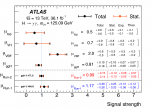The ATLAS-LAPP group played a key role in the discovery of the Higgs boson in its decay to two photons. Today this decay is used to perform a precise study of Higgs boson differential production cross sections as a function of the different kinematic variables, such as the number of co-produced jets.
At the heart of the group’s work is the measurement of the couplings of the Higgs boson and its "Simplified Template Cross Sections" (STXS):
the group is invested in several aspects of the analysis: the modeling of background noise, the optimization categories enriched in certain modes of production using a machine learning approach, statistical processing and theoretical interpretation. The results are interpreted using an approach based on an Effective Lagrangian (Effective Field Theory, EFT), which makes it possible to identify phenomena beyond the Standard Model.
Part of the group work is naturally devoted to studying and optimizing the performance of photon energy calibration, and improving techniques for identifying candidate photons with respect to decay-induced noise. of neutral hadrons in the jets. The group also contributes to the combination in ATLAS of all the measurements of the Higgs boson couplings in the different decay channels, and to the EFT interpretation of this combination.
Last but not least, observing the coupling of the Higgs with itself remains one of the major objectives of the LHC program and ATLAS-LAPP group.
Contacts: Marco Delmastro, Nicolas Berger.
Recent publications:
- ATLAS Collaboration, "Combined measurements of Higgs boson production and decay using up to 80 fb^−1 of proton-proton collision data at √s= 13 TeV collected with the ATLAS experiment"
- ATLAS Collaboration, "Interpretations of the combined measurement of Higgs boson production and decay" ATLAS-CONF-2020-053
- ATLAS Collaboration, “Observation of Higgs boson production in association with a top quark pair at the LHC with the ATLAS detector”
- ATLAS Collaboration, “Measurements of Higgs boson properties in the diphoton decay channel with 36 fb^−1 of pp collision data at √s = 13 TeV with the ATLAS detector”

















